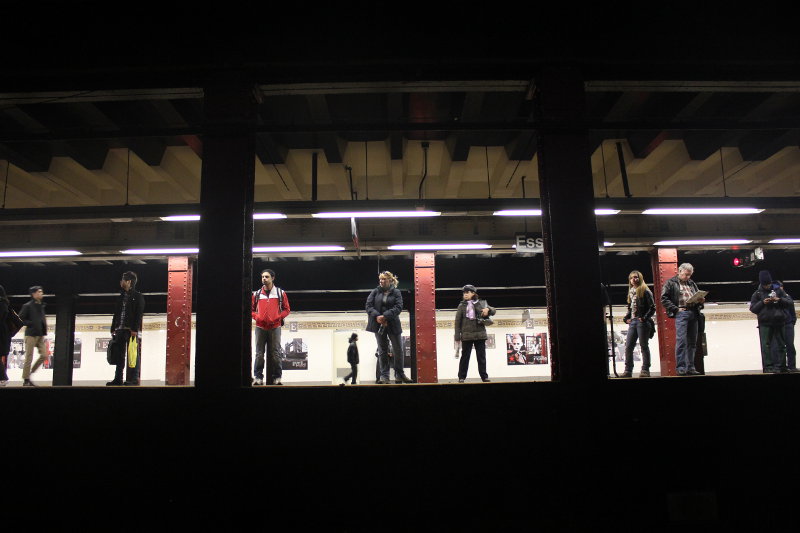March 12, 2012


NEW YORK- Most New Yorkers have no idea that they may be walking above long-forgotten underground tunnels and railways, relics of the horse-drawn trolleys and electrified cars of the early 20th century. There are at least 13 acres of unused tunnels throughout the five boroughs, many of them unsafe and unusable. As technology evolved, these systems became obsolete and fell into disuse. Now, however, there is a chance to turn them into environmentally friendly parks with natural lighting systems that bring sunshine underground. (Photo by Daniel H. Fuchs)
[nggallery id=126 template=carousel images=12][imagebrowser id=126] By Debra Atlas March 11, 2012 NEW YORK— Most New Yorkers have no idea that they may be walking above long-forgotten underground tunnels and railways, relics of the horse-drawn trolleys and electrified cars of the early 20th century. There are at least 13 acres of unused tunnels throughout the five boroughs, many of them unsafe and unusable. One such site is located underneath the Lower East Side (LES), and could soon become an unlikely green sanctuary. The Delancey Underground, site of the former Williamsburg Trolley Terminal, is a 1.5 acre area located at the LES foot entrance to the Williamsburg Bridge. This huge underground space – almost two-thirds the size of New York’s Grammercy Park– is managed by New York’s Metropolitan Transportation Authority (MTA). It was in active use from October 1905 until it was abandoned in 1948. Two men with a vision want to transform this deserted underground space into an incredible subterranean public park filled with light and greenery, utilizing cutting edge design and green technology. James Ramsey, a principal of the architectural firm RAAD Studio in New York and Dan Barasch, Vice President of the social innovation network PopTech, have charted the course from abandoned plot to public park.
[youtube]UdQO81E8kQ0[/youtube]
Delancey is one of the largest contiguous sites underground in all the boroughs, says Barasch. Not to mention, it’s in an interesting part of the city. This area of Delancey Street is a vital corridor. Its history dates back to famed urban builder Robert Moses and the destruction of huge swaths of tenement buildings, homes to many first-generation immigrants fresh from Ellis Island, to make way for newer, more modern public housing. “This neighborhood represents so much to so many people,” Barasch says. It also has its issues. A number of intersections of Delancey Street are the least safe streets in the city. One of the widest New York streets runs by the foot of the bridge. Drivers and cyclists are routinely injured or die in accidents on Delancey Street, according to Barasch. The Delancey Underground, also known as the Low Line, is the kind of idea that helps solve problems the community’s been fighting for generations, according to Barasch. “It’s a unique opportunity and a unique site,” he says. This project was inspired by the vision and success of New York’s High Line, the project pioneered by Joshua David and Robert Hammond that transformed an abandoned elevated freight rail line on the Upper West Side into a unique and popular above-ground public green space. “The High Line has been an amazing inspiration for entrepreneurs and people who are looking at reclaiming sites in the city,” says Barasch. Because of High Line, he says, the Lower East Side community can imagine this kind of park from a repurposed space. “They made it possible,” he says. Ramsey, who transitioned into design after working for NASA, created an innovative technology that will be used in the underground. The system can capture sunlight that is then concentrated and transferred underground through tiny fiber optic cables. Street-level solar collectors will collect sunlight during the day, then reflect it underground without passing on any harmful UV rays. The system distributes light wavelengths that encourage photosynthesis, allowing all sorts of greenery to thrive. This creates “remote skylights” in Delancey Street that bathe the underground park in sunshine. “We’re channeling sunlight the way they did in ancient Egyptian tombs, but in a super-modern way,” says Ramsey. Barasch says the business community, the political community, and local residents have all come out to support them and are excited about the idea. Interestingly, the abandoned trolley terminal can be seen from the existing Delancey Street subway station that’s adjacent to it when facing towards the Brooklyn platform. This offers an integrated, creative space that would offer the subway experience as well as offering a new urban park, says Barasch. Barasch and Ramsey started a Kickstarter campaign with the goal of raising $100,000 by April 6; they’ve already raised over $130,000. Once funding is in place, the next step will be constructing a full scale mini-Delancey Underground on Essex Street this September. This will hopefully lead to the construction of an exhibition of the technology they’ll use and to the creation of a public indoor park. On the question of safety once the Underground is built, Barasch noted that the High Line has been incredibly devoid of crime since its opening. Like that park, Barasch says they plan to manage theirs by limiting nighttime hours and having the equivalent of park stewards. The site has become a commodity to the MTA, which is looking to liquidate its real estate assets. Baracsh says his organization is the only one that has created a community-oriented plan for public space. However, for it to go forward, they’ll still need to win the right to build Delancy Underground from the MTA later this year. The Underground’s co-creators envision year-round programming series, encompassing a variety of events including art exhibitions, farmers’ markets, educational series, special events and promotions. “It’s the beginning of a Renaissance, and it’s challenging our cities to be more than they are,” he says. To learn more or to get involved in this exciting project, visit the Delancey Underground’s Kickstarter page or Facebook page. Read more articles by Debra Atlas © 2012 SCGH, LLC.]]>